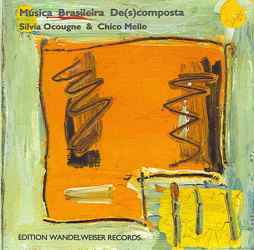EDITION WANDELWEISER RECORDS
> CD catalogue
_____________________________________________________________________
<< >>
Chico Mello & Silvia Ocougne
Musica Brasileira De(s)composta
| order
reference:
medium: composer: performer: |
EWR 9603 CD Silvia Ocougne, Chico Mello Silvia Ocougne, Chico Mello |
 |
Silvia Ocougne and Chico MeIlo, both Brasilians, came to Berlin independently at about the same time. Both of them are multi-instrumentalists with a particular interest in guitar and contemporary composition. Profiting from the advantage of being in a ,,foreign culture" on an ,,older continent", Chico and Silvia have created a sonic collage of traditional popular and contemporary elements in the light of influences from Berlin and Brazil. Surrounded by an unusual constellation of instruments induding tuba, matchbox, clarinet, etc.; the central instrumental metaphor of these recordings remains the guitar: the ,,tabula rasa" of international musics. "Bebê" and ,"1XO" are two guitar collages in which layers of free improvisations are superimposed on each other In ,,Berimbau", the basic themes of the improvisations are fragmented. Our focus of antecipation shifts horizontally and vertically through these multiple guitars and thematic motifs. ,,Do Lado do dedo" (,,On the other side of the finger") refers to the tactile experience of "touching" the guitar: expanding its limitations as a string and percussion instrument and at times using unusual preparations. ,,Dentro do Tubo l and II" (,,Inside the Tube l and II") are comprised of recognizable song-fragments. Russian Military tubas and clarinets are used here as voice-filtering resonating cavities, as percussive surfaces and as thumping air containers. lt is a déjà-vu of images between two characters who are no longer playing ,,on" their instruments, but have entered into their instruments’ own world. ,,Samba e Amor", ,,Trem das Onze" (,,Samba and Love", "Eleven o'clock Train") takes on a journey with prepared guitar; matchbox ensemble, noise and silence. ,,John Cage na praia" (John Cage at the Beach No. 1-4) are collages where the basic materials (fragments of songs, classical pieces, and noise) have been de-constructed and displayed in space, ilIuminating a fundamental ground of silence. |
> top